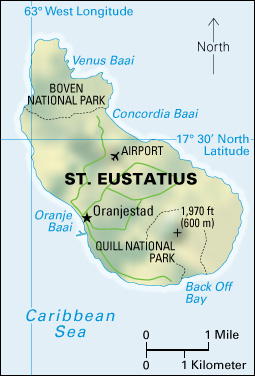Saint Eustatius (pop. 3,000), also called Statia or, in Dutch, Sint Eustatius, is an island in the Caribbean Sea. It is part of an island group called the Lesser Antilles. Saint Eustatius is also called Statia or, in Dutch, Sint Eustatius. Since 2010, Saint Eustatius has been an overseas municipality of the Kingdom of the Netherlands. Its political status resembles that of a Dutch city. Previously, it was part of the Netherlands Antilles, which was a largely self-governing part of the Kingdom of the Netherlands. The island is 8 square miles (21 square kilometers) in area. The population is concentrated in the capital, Oranjestad, on the southwestern coast of the island. Dutch, English, and Papiamento all are official languages, but most people use English as their common language.

Although breadfruit, banana groves, and palm trees grow on the island’s sheltered western coast, St. Eustatius is too dry to support much agriculture. There is some lobster fishing. Tourism is of increasing importance. A regular air service links St. Eustatius with nearby Saba and St. Martin. Attractions on the island include its two extinct volcanoes. One of these, the Quill, has a tropical forest growing in its crater.
St. Eustatius was first colonized by the French and British in 1625. The island became a center of the slave trade. Dutch, French, and British settlers fought over it, and the island changed hands many times. St. Eustatius supported the American Colonies in the late 1700’s in their struggle for independence from the United Kingdom. It was the first foreign territory to officially acknowledge the independence of the United States. In retaliation, the British captured St. Eustatius in 1781 and destroyed much of its infrastructure.
See also Netherlands Antilles .
